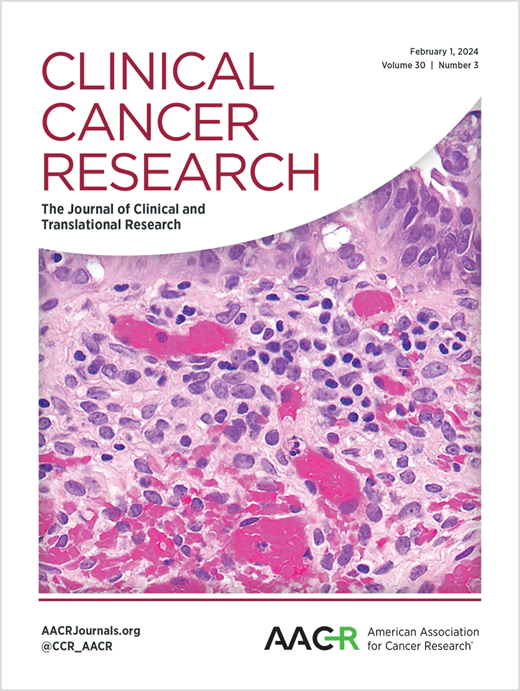基于microrna的生殖系特征预测前列腺癌辐射毒性的验证和推导
IF 10
1区 医学
Q1 ONCOLOGY
引用次数: 0
摘要
目的:虽然放射治疗(RT)是用于治疗癌症的主要治疗方式之一,但患者经常在治疗期间或治疗后出现毒性。rt诱导的泌尿生殖系统(GU)毒性对前列腺癌(PCa)患者的生存是一个重大挑战,但识别那些有风险的患者一直具有挑战性。在此,我们试图(i)验证先前鉴定的晚期rt诱导的GU毒性的生物标志物PROSTOX,主要由基于microrna的种系生物标志物(mirsnp)组成,以及(ii)研究从时间和基因上定义其他形式的rt相关GU毒性的可能性。实验设计:我们纳入了148名参加MIRAGE (NCT 04384770)的患者,这是一项比较MRI与ct引导的前列腺立体定向放疗(SBRT)的试验。采用线性回归评价PROSTOX评分与晚期GU级毒性之间的关系。使用机器学习方法建立急性和慢性GU毒性的预测模型,并使用曲线下面积(AUC)指标评估所有模型的准确性。进行了比较基因本体(GO)分析。结果:PROSTOX准确预测晚期GU毒性,AUC为0.76,与GU毒性等级(p-1.2E-9)有很强的相关性。基于mirsnp的特征可以区分急性和慢性RT毒性(auc分别为0.770和0.763)。最后,氧化石墨烯分析确定了与每种形式的GU毒性有关的独特途径&;#45;-;急性、慢性和晚期。结论:这些发现为继续应用mirsnp预测RT毒性提供了强有力的证据,并作为持续个性化RT治疗的途径,改善了患者的预后。本文章由计算机程序翻译,如有差异,请以英文原文为准。
Validation and Derivation of MicroRNA-based Germline Signatures Predicting Radiation Toxicity in Prostate Cancer
Purpose: While radiation therapy (RT) is one of the primary treatment modalities used in the treatment of cancer, patients often experience toxicity during or after treatment. RT-induced genitourinary (GU) toxicity is a significant survivorship challenge for patients with prostate cancer (PCa), but identifying those at risk has been challenging. Herein, we attempt (i) to validate a previously identified biomarker of late RT-induced GU toxicity, PROSTOX, consisting primarily of microRNA-based germline biomarkers (mirSNPs), and (ii) to investigate the possibility of temporally and genetically defining other forms of RT-associated GU toxicity. Experimental Design: We included 148 patients enrolled in MIRAGE (NCT 04384770), a trial comparing MRI versus CT-guided prostate stereotactic body radiotherapy (SBRT). Linear regression was used to evaluate the association between PROSTOX score and late GU grade toxicity. Machine learning approaches were used to develop predictive models for acute and chronic GU toxicity and the accuracy of all models was assessed using area under the curve (AUC) metrics. A comparative gene ontology (GO) analysis was performed. Results: PROSTOX accurately predicts late GU toxicity, achieving an AUC of 0.76, and demonstrates strong correlation with GU toxicity grade (p-1.2E-9). mirSNP-based signatures can distinguish acute and chronic RT toxicity (AUCs of 0.770 and 0.763). Finally, GO analysis identifies unique pathways involved in each form of GU toxicity -- acute, chronic and late. Conclusions: These findings provide strong evidence for the continued application of mirSNPs to predict toxicity to RT, and to act as a path for the continued personalization of RT with improved patient outcomes.
求助全文
通过发布文献求助,成功后即可免费获取论文全文。
去求助
来源期刊

Clinical Cancer Research
医学-肿瘤学
CiteScore
20.10
自引率
1.70%
发文量
1207
审稿时长
2.1 months
期刊介绍:
Clinical Cancer Research is a journal focusing on groundbreaking research in cancer, specifically in the areas where the laboratory and the clinic intersect. Our primary interest lies in clinical trials that investigate novel treatments, accompanied by research on pharmacology, molecular alterations, and biomarkers that can predict response or resistance to these treatments. Furthermore, we prioritize laboratory and animal studies that explore new drugs and targeted agents with the potential to advance to clinical trials. We also encourage research on targetable mechanisms of cancer development, progression, and metastasis.
 求助内容:
求助内容: 应助结果提醒方式:
应助结果提醒方式:


